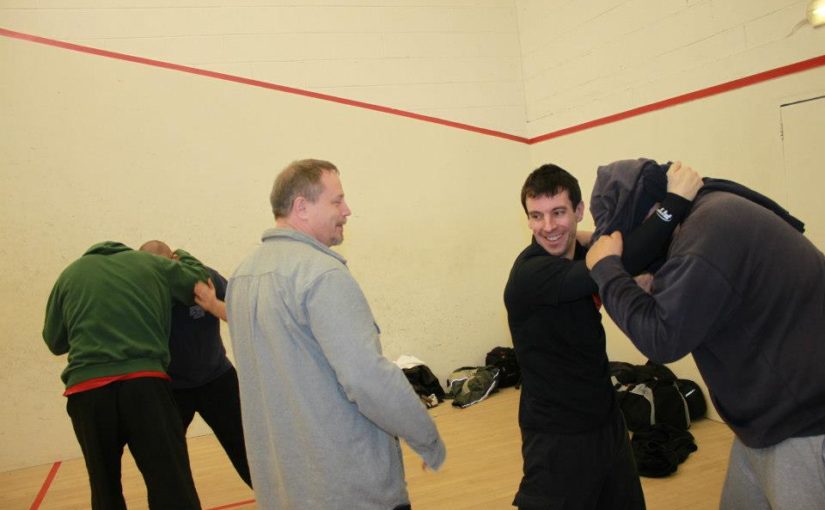Part One Laying the Foundation
Managing conflict can be approached as a huge and complex field. You can find books of techniques, lists of indicators to watch for. You can fill your mind with endless datum and detail. This approach, whether in a verbal communication class or a martial arts class, is common. It is also, in my opinion, largely ineffective. It is teaching and memorizing trivia so that one can give the impression of understanding. This gives the student reams of knowledge and completely bypasses understanding. This approach is the downfall of much of the technique-based training in the martial arts, producing people that can throw a visually perfect punch, but can’t fight. Useless to the student, but the teacher has nice clear lesson plans and infinite detail to correct.
Conflict management can also be ignored: “It’s a natural part of your life, something you see every day. You don’t need to be taught this.” This approach leads to improvement only through trial and error, and error can be expensive in conflict. It doesn’t even require a teacher, and I have seen it used as an excuse not to teach critical skills to rookies.
And conflict can be deliberately mismanaged and mistaught: “I don’t need to learn how to manage conflict! Everyone else just has to learn to be nice to me.” Which is not just an expression of pure selfish ego, but designed to keep anyone who takes that stance as helpless and dependent as possible.
All three of these approaches are easy to teach. I mean that the process is easy for the teacher. They are not good ways to develop complex skills in the students.
Principles-based teaching is more challenging for the instructor. The instructor can’t get away with just parroting what he or she was taught. It requires a depth of understanding.
“You must turn your toe out at 45 degrees in this technique,” is sufficient for technique-based instruction. The foot position is part of the technique, defines whether the technique is correct or not. The teacher and student can both see it. The teacher can grade it, and if it is taught consistently, the foot position will be part of the system far into the future. A tiny bit of information is all that is necessary, and no real thought whatsoever.
You must turn your toe out at 45 degrees either has a mechanical advantage or it doesn’t, simple as that. There is a simple law of physics or physiology that makes that foot position important (in that position/time/situation) or there isn’t. And if there is, that 45 degrees will be completely wrong in a different situation.
Technique based: “You must turn your toe out at 45 degrees in this technique.”
Principles based: “Generally, you want to keep your knees bending over your toes to keep your knees from getting injured.”
Learning your principles is getting into the “why” of things. Why do techniques work or fail? What are the physics of techniques in general?
The “why” leads to the “how.” Once you understand the principles and start learning how to apply them in action, the “whats” (the techniques) flow from that. They don’t need to be taught, because they can be automatically derived.
That may seem counter-intuitive, and it would be if the training methods of rote training were applied. More on methods later.
You need a few things to get skilled at this way of teaching:
- You need to understand the principles of your system inside and out
- You need to understand the goal of your training
- You need to have a way to gauge (I did not say measure) progress towards that goal
- You need to know your audience/students
- You need a thorough understanding of how humans learn complex skills
- And you need humility, because your students will get good, maybe better than you, very quickly
After outlining this teaching method to a very successful school owner in another country I got one of the best compliments of my life. “I see what you’re doing, but you couldn’t keep a school running that way. The students will get too good too fast. There’s no way to make a living at it.” Cool. But I don’t think he meant it as a compliment.
Understanding principles will come in a later article. If you want homework, though, here it is: Sit down and derive a list of the principles critical to your system.
How do I define a principle? Principles are the underlying things that make techniques work. It’s a principle if it applies to striking, grappling and weapons and there are no exceptions. Leverage, for example, is critical to all three and good leverage is always superior to poor leverage. Now, I went with my hand-to-hand core there, but you can pick anything– business, gardening, negotiations, auto mechanics– and there will be a solid core of principles.
Understand the goal of your training. This one blends with gauging, knowing your audience and humility. Quite simply, many people are not teaching what they think they are teaching. They intend to teach self-protection but put hours into how to win a one-on-one sparring match against a friend in a controlled environment.
Gauging your training. People like measurability. “That which gets measured gets improved.” But in certain fields, measurability has almost no correlation with applied ability. The arrest and control techniques taught at police academies are often complex, multi-step locks. Very easy to grade the students in class, almost impossible to apply in real life. In high school or college, were the people getting A’s in English or Communications the ones getting dates?
For physical skills, and particularly self-defense, there is no way to measure. The only applicable measurement would be whether someone survived, and the possible range of dangers makes survival in one situation likely irrelevant to the next. You can’t truly measure it, but you can and should develop ways to gauge progress and to see what progress is needed. Conflict management is an open-ended skill. Neither you nor your students will ever get to the end point where you know it all.
You need to know your audience/students. In my mind, the biggest division between martial arts and self-protection is that in MA I am teaching subject matter, and in SP I am teaching students.
Each student is different. They all have different abilities, strengths, talents, resources and weaknesses. They will be targeted for very different types of conflict. Further, they will each have different learning styles.
Understand teaching. Most of what we know or what we think we know about teaching comes from our own experience as students in schools, primarily grammar school and high school. Those were places of regimentation, top-down training, with huge power disparities between the instructor and student. Measurability trumped applicability. And everything was aimed at teaching children, not adults.
It would be hard to design a worse model for teaching assertiveness or conflict management. You can’t teach people to be strong while demanding that they obey.
Principles-based teaching has to be applied with principles of teaching. And principles of learning.
Humility. In conflict training, the instructor’s ego is probably the student’s most dangerous enemy. The instructor will be trusted, will be seen to have the answers. If the instructor needs or desires a sycophantic relationship, it will be toxic to the student. If the instructor is too prideful to acknowledge what he doesn’t know and makes shit up to answer questions, he actively endangers his students. All of teaching is about creating students who will be better than you. If you can’t emotionally handle not being the best, you have no business teaching.
This is the end of Part One, laying the foundation. I’m going to make a suggestion. If you can get a copy, watch my video “JointLocks” available from YMAA.com, Amazon and, I believe as an app. It’s not really about the locks. My stealth purpose for shooting that video was to get a solid example of the principles-based approach in front of people. Locks have a reputation for being difficult. The method we show in the video has gotten untrained rookie cops improvising locks under stress in one hour of training. If you get a chance, watch the video, but for the training method, not just the locks.— Rory






